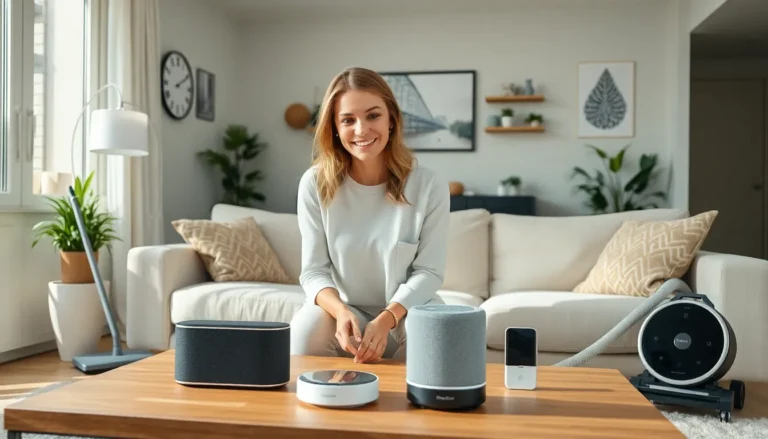In a world where swiping right can lead to love or a hilarious disaster, dating apps have revolutionized the way people connect. Gone are the days of awkward blind dates and chance encounters at the coffee shop. Now, with just a few taps on a screen, anyone can find their perfect match—or at least a decent pizza buddy for Friday night.
Table of Contents
ToggleOverview Of Dating Apps
Dating apps revolutionized how people form relationships, transforming traditional methods into a convenient digital experience. These platforms facilitate connections for various relationship types, enhancing social interactions.
History And Evolution
Dating apps emerged in the early 2000s. The first notable platform, Match.com, launched in 1995 but gained popularity in the following years. Following this, other apps like eHarmony and OkCupid introduced algorithms to match users based on compatibility. Notably, the rise of mobile devices sparked significant growth in app-based dating, with Tinder’s launch in 2012 marking a shift toward swiping mechanics. The evolution of dating apps now offers diverse options, catering to specific preferences and demographics.
Popular Platforms
Several platforms dominate the dating app landscape, catering to various needs. Tinder stands out for its swiping feature, attracting a younger demographic seeking casual connections. Bumble empowers women by allowing them to make the first move, fostering a more balanced interaction. Hinge focuses on relationship-building, encouraging meaningful conversations through prompts. For niche interests, apps like Grindr cater to the LGBTQ+ community, while FarmersOnly targets rural singles. Overall, each platform offers unique features, making them appealing to specific audiences.
Pros And Cons Of Dating Apps

Dating apps offer unique advantages and challenges for users. Understanding these aspects helps individuals make informed decisions about their dating experiences.
Advantages
Increased convenience stands out as a primary benefit of dating apps. Users can connect with potential partners anytime and anywhere through their smartphones. Diverse options make it easier to find matches based on specific interests and preferences. Apps cater to various demographics, allowing individuals to meet others they might not encounter in their everyday lives. Enhanced communication features facilitate interaction before meeting in person, which can build rapport. Safety measures, such as profile verification and block features, also contribute to a sense of security in online dating.
Disadvantages
Despite their perks, dating apps also come with notable downsides. Users often encounter issues like superficial connections, as profiles can prioritize appearance over compatibility. Time investment becomes significant when swiping through numerous profiles, leading to decision fatigue. Misrepresentation poses a risk; individuals may not present their true selves online. Emotional challenges arise, as rejection can feel more pronounced in a digital realm. Finally, some users report a decrease in face-to-face social skills due to reliance on apps for interaction.
Key Features To Look For In Dating Apps
Choosing the right dating app involves considering several key features that enhance the overall experience. Users often prioritize unique functionalities that align with their dating goals.
User Interface And Experience
A seamless user interface improves engagement and interaction. Intuitive navigation allows users to browse easily and find potential matches quickly. Clean, organized layouts contribute to a pleasant experience. Users appreciate features such as profiles that display essential information prominently. Engaging visuals or elements like swipe mechanics can help capture attention efficiently. Additionally, responsive designs work well on various devices, providing access anywhere, anytime.
Safety And Security Measures
Safety features are essential for user confidence. Apps often implement verification processes to reduce the risk of fake profiles. Robust privacy settings allow users to control what information others can see. Many platforms include reporting tools for inappropriate behavior, creating a safer environment. Features such as in-app messaging protect personal phone numbers, enhancing user safety. Lastly, some apps provide resources or tips on safe dating practices, fostering a secure atmosphere for connections.
Effectiveness Of Dating Apps
Dating apps significantly influence relationship dynamics. These platforms foster connections through user-friendly features, diverse options, and convenience.
Success Stories
Numerous individuals report finding meaningful relationships through dating apps. Users often share testimonials that highlight long-term partnerships sparked by these platforms. Relationships formed via apps like Hinge and Bumble lead to successful marriages and lasting commitments. Some users emphasize how specific matchmaking algorithms enhance compatibility, making it easier to connect with potential partners. These technologies contribute to positive experiences, demonstrating that dating apps facilitate genuine connections for many people.
Criticism And Challenges
Critics often highlight concerns regarding superficial interactions on dating apps. Users may struggle with the overwhelming number of choices, leading to decision fatigue. Misrepresentation occurs frequently, as individuals may present unrealistic portrayals of themselves. Emotional challenges also arise, with many users facing rejection and disappointment frequently. Despite built-in safety features, online dating still carries certain risks. Navigating these challenges is essential for users to maximize their experiences while using dating apps.
Dating apps have undeniably reshaped the landscape of modern relationships. They offer unparalleled convenience and a vast array of options for individuals seeking connection. While the benefits are significant the challenges cannot be overlooked. Users must navigate potential pitfalls like superficial interactions and emotional hurdles.
Ultimately, the success of dating apps hinges on how individuals approach their experiences. By understanding the unique features and dynamics of each platform users can make informed choices that align with their relationship goals. Embracing both the advantages and challenges can lead to fulfilling connections in today’s digital age.



